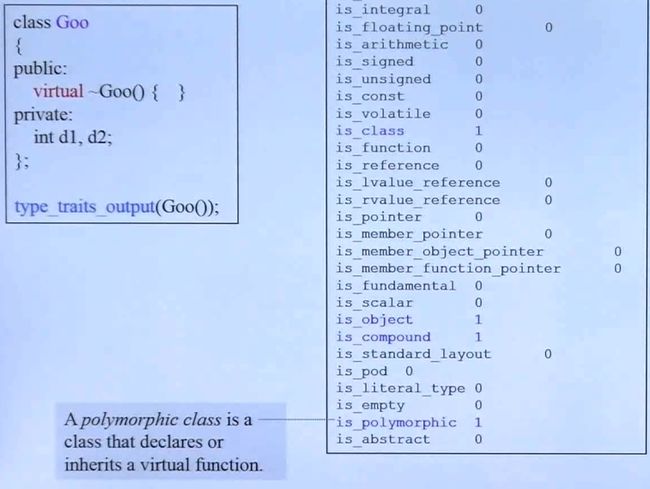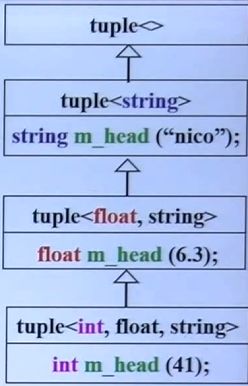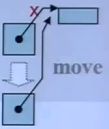侯捷 C++ STL标准库和泛型编程 —— 9 STL周围
最后一篇,完结辽!
9 STL周围
9.1 万用Hash Function
Hash Function的常规写法:其中 hash_val 就是万用Hash Function
class CustumerHash
{
public:
size_t operator()(const Customer& c) const
{ return hash_val(c.fname(), c.lname(), c.no()); }
};
还可以直接用函数实现,或者写一个
hash的特化版本
原理:
通过三个函数重载实现从给入数据中逐一提取来不断改变 seed
// 第一个函数 首先进入该函数
template <typename... Types>
inline size_t hash_val(const Type&... args)
{
size_t seed = 0; // 设置初始seed
hash_val(seed, args...); // 进入第二个函数
return seed; // seed就是最后的HashCode
}
// 第二个函数 该函数中逐一提取一个参数
template <typename T, typename... Types>
inline void hash_val(size_t& seed, const T& val, const Types&... args)
{
hash_combine(seed, val); // 逐一取val,改变seed
hash_val(seed, args...); // 递归调用自己,直到取完进入第三个函数
}
// 第三个函数
template <typename T>
inline void hash_val(size_t& seed, const T& val)
{
hash_combine(seed, val); // 取最后一个val,改变seed
}
// 改变seed的函数
template <typename T>
inline void hash_combine(size_t& seed, const T& val)
{
// 乱七八糟的运算,越乱越好
seed ^= hash<T>()(val) + 0x9e3779b9 + (seed<<6) + (seed>>2);
}
C++11中 variadic templates:
从传入的内容(任意个数,任意元素类型)分为一个和其他,递归再分为一个和其他······
0x9e3779b9:是黄金比例!
9.2 Tuple
可以将一些东西组合在一起
9.2.1 用例
-
创建
tupletuple<string, int, int, complex<double>> t; tuple<int, float, string> t1(41, 6.3, "nico"); auto t2 = make_tuple(22, 44, "stacy"); -
输出
tuple// 输出t1中的第一个 cout << get<0>(t1) << endl; // 41 cout << t << endl; // 在VS2022上并没有<<的重载 -
运算
t1 = t2; if(t1 < t2) // 以特定的方式进行的比较 { ... } -
绑定解包
tuple<int, float, string> t3(77, 1.1, "more light"); int i; float f; string s; tie(i, f, s) = t3; // i == 77, f == 1.1, s == "more light" -
// tuple里有多少类型 tuple_size< tuple<int, float, string> >::value; // 3 // 取tuple里面的类型,前面一堆代表float tuple_element<1, TupleType>::type fl = 1.0; // float fl = 1.0;
9.2.2 原理
依然是使用 variadic templates,通过递归继承,不断从 ... 中提取内容
// 空的tuple
template <> class tuple<> {}; // 直到取完
// tuple主体
template <typename Head, typename... Tail>
class tuple<Head, Tail...>
: private tuple<Tail...> // 递归继承
{
typedef tuple<Tail...> inherited;
public:
tuple() {}
tuple(Head v, Tail... vtail)
: m_head(v), inherited(vtail...) {}
...
protected:
Head m_head; // 每次取出的元素
};
其余函数:
...
{
public:
...
Head head() { return m_head; }
inherited& tail() { return *this; } // 通过转型获得Tail部分
...
};
9.3 type traits
9.3.1 用例
GCC2.9中:
默认的 __type_traits 进行了一系列泛化的设定(trivial 是不重要的意思)
struct __true_type {};
struct __false_type {};
template <class type>
struct __type_traits
{
typedef __true_type this_dummy_member_must_be_first;
typedef __false_type has_trivial_default_constructor;
typedef __false_type has_trivial_copy_constructor;
typedef __false_type has_trivial_assignment_operator;
typedef __false_type has_trivial_destructor;
typedef __false_type is_POD_type; // Plain Old Data 类似C的struct
};
还会通过特化来实现针对不同类型的设定,例
template <> struct __type_traits<int>
{
typedef __true_type has_trivial_default_constructor;
typedef __true_type has_trivial_copy_constructor;
typedef __true_type has_trivial_assignment_operator;
typedef __true_type has_trivial_destructor;
typedef __true_type is_POD_type;
};
C++11中:
有了很多个 type traits,可以回答更多问题
测试:
cout << is_void<T>::value << endl;
cout << is_integral<T>::value << endl;
cout << is_floating_point<T>::value << endl;
cout << is_array<T>::value << endl;
...

不论是什么类型都可以自动检测它的 traits,非常厉害!(里面有虚函数——就能自动检测出它有多态性)
9.3.2 原理
模板的作用
例 is_integral
依然是采用的一种问答的方式实现的
template <typename _Tp>
struct is_integral
:public __is_intagral_helper<typename remove_cv<_Tp>::type>::type
{ };
首先 remove_cv(const 和 volatile)
// 通过偏特化实现remove const
template <typename _Tp>
struct remove_const
{ typedef _Tp type };
template <typename _Tp>
struct remove_const<_Tp const>
{ typedef _Tp type };
// remove volatile 同理
再通过 __is_intagral_helper 进行问答
// 通过偏特化实现
template <typename>
struct __is_integral_helper
:public false_type { };
template <>
struct __is_integral_helper<bool>
:public true_type { };
template <>
struct __is_integral_helper<int>
:public true_type { };
template <>
struct __is_integral_helper<long>
:public true_type { };
...
其他深入 class 内部的一些 traits 比如是否有虚函数,是否是一个类,是否是POD等等,其实现可能都与编译器有关
9.4 move
moveable class 中有:
// move ctor
MyString(MyString&& str) noexcept // 用&&与普通版本区别开
: _data(str._data), _len(str._len)
{
str._len = 0;
str._data = NULL; // 避免析构函数释放资源
}
// move assignment
MyString& operator=(MyString&& str) noexcept
{
if (this != &str)
{
_len = str._len;
_data = str._data;
str._len = 0;
str._data = NULL; // 避免析构函数释放资源
}
return *this;
}
// dtor
virtual ~MyString()
{
if(_data) delete _data; // 一定要检查
}
MyString C11(C1); // ctor
MyString C12(move(C1)); // move ctor
对于 vector 这样的容器,其用 move 就只是 swap 了三根指针,非常快!
move 之后原来的东西不能再使用,比如拿数据插入容器,用临时对象,编译器看到就会自动使用 move 版本的
MyString C11(C1);时,创建了一个实例 C11,编译器就不知道是否能用 move,就需要自己MyString C12(move(C1));使用 move,但注意之后==一定不能用原来的C1==
&&(右值引用)这是C++11引入的特性,右值引用用于处理临时对象或将资源所有权转移给其他对象,以提高性能和资源管理


